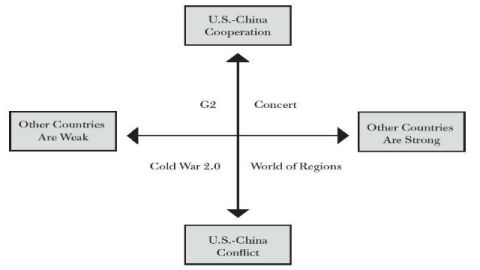A World Without Leadership: Ten Questions with Ian Bremmer (Part 2)

Editor’s Note: In a previous post, Ali Wyne published the first part of his interview with Ian Bremmer about the main argument of Bremmer’s new book, Every Nation for Itself: Winners and Losers in a G-Zero World: namely, that no one can meet the challenges of global leadership right now.
Here is the second part of that interview:
POWER GAMES: You argue that “in a G-Zero world, China is the major power least likely to develop along a predictable path….The country’s rise is unstable, unbalanced, uncoordinated, and unsustainable” (p. 148).
What’s the range of alternative futures for China?
IAN BREMMER: China’s GDP is second in the world, but its GDP per capita has not yet cracked the top 90. It has about half the per capita income of Lithuania and one third that of Portugal. One of the responses to this obstacle in China’s path towards building a 21st-century economy with a deep and broad middle class capable of sustaining it is a public acknowledgment in Beijing that China’s consumers must hold a much larger share of the country’s wealth. China has to rely less for growth on exports to Europe and America and more on Chinese consumption of Chinese-produced goods and services. This challenge could open a big rift within the leadership between those who are determined to follow this path and those who profit too much from the current system to allow for such a fundamental change.
Since the events of 1989, both in Tiananmen Square and across Eastern Europe, the Chinese leadership has done its best to keep high-level disagreements out of the public eye. If, over time, noisy elite disputes over reform spill out onto the street, we could see a dangerous spike in unrest that threatens the Communist Party’s monopoly on political power and/or a more aggressive China on the international stage as party leaders seek to divert attention away from internal problems toward anger at foreign scapegoats.
Then there’s the danger that comes from outside the inner circle. A WikiLeaks-type scandal within China, one where high-level party documents and communications are suddenly made public through cyberattack, espionage, or some other method, would create instant turmoil within the party leadership. From the outside, China’s government appears very cohesive. But there’s brittleness underneath. Given the importance of China for the global economy, that’s the single-largest driver of political risk and volatility in the world today.
The rosier scenario is one in which the G-Zero creates the kinds of problems that actually align Chinese and Western interests, for example, by producing a lasting spike in energy prices or a threat to energy supplies that forces major importing nations like China, America, and others to cooperate on both near-term and longer-term solutions.
PG: Is India a winner or loser in the G-Zero?
IB: It’s a near-term winner because the desire of U.S. officials and many of China’s neighbors to hedge against China’s expansion gives India a wide variety of options in developing new political and commercial relationships. (We caught a glimpse of this in recent days with the muted U.S. reaction to an Indian missile test.) Longer term, India will have to compete more directly with China, and its success will depend mainly on the quality and vision of its leadership.
PG: You observe that while “Asia will be the biggest contributor to global economic growth over the next many years” (p. 120), “Asian conflict will be the biggest global hazard in the years to come” (p. 72).
Are we looking at an Asian century, then, in both good and bad ways?
IB: As I mentioned above, centuries have become far too big a block of time to consider as a single coherent era. That said, in coming years, Asia will provide both economic energy and geopolitical conflict. On the one hand, many of the likeliest drivers of global growth are in Asia. There are China, India, and Japan (still the world’s third-largest economy), but there are also Indonesia, Thailand, Vietnam, and several other promising markets that can restore some much-needed dynamism in the global economy. But Asia also has very little in the way of institutional architecture that could help mitigate the risk of conflict. There is no Asian Union, and no Asian equivalent of NATO to provide a security umbrella. There are plenty of regional groupings, but all of them exclude at least one major player from their ranks. Thus, we’ll see both the productive and the more worrisome forms of “competition.”
I would add that any idea of an Asian century or an Asian era underestimates U.S. resilience. The future will belong to those who can adapt, invent, and sell. That’s why it’s absolutely foolish for anyone to assume that America is in some sort of inexorable long-term decline.
PG: In the fourth chapter, you discuss which countries, institutions, companies, and individuals are poised to win in the G-Zero, and which ones are likely to lose. How about political-economic models? In your last book, The End of the Free Market: Who Wins the War Between States and Corporations? (New York: Portfolio, 2010), you concluded that “free markets will probably outlast state capitalism as it is now practiced in China, Russia, the Gulf States, and elsewhere” (p. 171).
Two years later, do you have any reason to revise that judgment? Are there any political-economic models besides market capitalism and state capitalism that could be viable for a sustained period?
IB: None at all. The governments of China and Russia have already recognized publicly that their growth models are not sustainable. There’s a big difference between admitting this and actually making the fundamental (and politically complicated) changes necessary to bring about real reform, but it’s no secret that developing nations don’t become developed nations until the state proves willing to embrace a system that generates a much larger share of wealth beyond the state’s control. Lousy economic conditions in Europe and the U.S. will make this a harder sell for the next several years, and governments on both sides of the Atlantic will continue to search for the right balance between market energy and intelligent regulation. But the Chinese and Russian governments can’t compete indefinitely if they continue to make life so hard for the private sector and for small and medium-sized businesses.
PG: You speculate that “if, instead of empowering the state to protect citizens from crisis, the G-Zero creates the kinds of problems that discredit the state, cripple its credibility, and arouse enough public anger that citizens look for alternatives” (p. 179), we might see a “G-Subzero”: “power fragments inside individual countries, control is divided between local and central leaders, and competition arises among power brokers within individual states” (p. 183).
Do you see the various manifestations of discontent around the world—whether the emergence of the Tea Party and Occupy Wall Street in the U.S., the revolutions that continue to convulse the Middle East and North Africa, and the riots in London and Greece—as evidence that a G-Subzero is growing more likely, or do you think that the current backlash against globalization will prove fleeting?
IB: Right now, it’s fleeting. The Tea Party has helped elect a few members of Congress, but neither this movement nor Occupy Wall Street has had much impact on how the U.S. is actually governed. In the Middle East, unless the Arab Spring generates serious upheaval in places like Saudi Arabia and Iran, which appears for the moment to be highly unlikely, regional change is likely to proceed by fits and starts. I certainly wouldn’t bet against Europe’s ability to gradually get its act together, given all of the architecture in place to backstop reform. China deals with serious unrest on a daily basis and shows no signs of buckling this year. Things got a bit noisy during Russia’s elections, but the party of power hasn’t had to give up much of its authority.
In other words, the state is holding up very well and has reasserted itself strongly over the past few years. No sign of a G-Subzero on the horizon. And that’s a good thing.
* The image at the top of this post is included with Ian’s permission; it depicts what he sees as the four possible post-G-Zero international systems.
Follow Ali Wyne on Twitter and Facebook.




